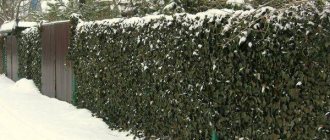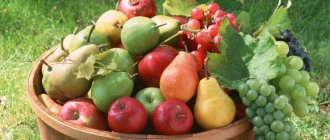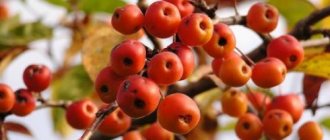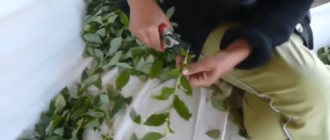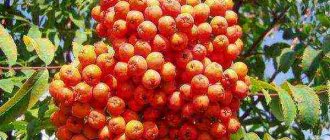Author: Natalia Category: Garden plants Published: February 22, 2019Last edits: November 04, 2020
- Growing conditions
- Fieldfare (Sorbaria tomentosa)
Fieldfare (lat. Sorbaria) is a genus of plants of the Rosaceae family, representatives of which grow naturally in Asia. There are 10 species in the genus. The scientific name of the genus comes from the Latin Sorbus, meaning "rowan", and is given to plants of this genus for the similarity of their leaves to those of the common rowan. Fieldfare have been grown as ornamental plants since the mid-18th century.
Planting and caring for fieldfare
- Flowering: in June, about a month.
- Planting: in autumn, at the end of leaf fall, or in spring, before sap flow begins.
- Lighting: bright light, partial shade or shade.
- Soil: any, even clay and wet.
- Watering: abundant, especially during drought.
- Top dressing: two or three per season with organic fertilizers: peat, humus, compost. Sometimes you can add a mineral complex.
- Pruning: in early spring, sanitary cleaning, thinning and rejuvenation of the bush are done, and root shoots are removed.
- Reproduction: by layering, lignified cuttings, dividing the bush, less often - by seed.
- Pests: spider mites, green aphids.
- Diseases: viral mosaic.
Read more about growing fieldfare below.
Botanical description
The fieldfare plant is a deciduous shrub up to 3 m high, which, due to its ability to produce a large number of root shoots, forms spectacular dense thickets. The shoots of the fieldfare are geniculate-twisting, yellowish-gray, the leaves are compound, imparipinnate, consisting of 9-13 pairs of serrate or double-serrate leaves. Numerous small white or creamy flowers are collected in pyramidal panicles. Fieldfare fruits are leaflets.
Fieldfare in landscape design is used for single and group plantings, as well as for hedges, strengthening slopes and decorating ponds.
How to effectively use rowan in landscape design?
Rowan - a deciduous stately tree or picturesque shrub with an openwork crown, graceful leaves, inflorescences in the form of elegant white or pink umbrellas and, of course, bright cheerful red, crimson, and sometimes orange clusters, so easily recognized by everyone since childhood - is readily used in landscape design.
This tree is truly made for decoration. The weeping form of the mountain ash is especially plastic and flexible. You can use it to build an arch not only over a gate, but also over a bench, use it in the decor of a gazebo, and generally allow it to show its special design talent wherever your heart desires. After all, its flexibility allows you to improvise so boldly!
This option will also help to emphasize the charm of the weeping form of rowan when this tree brightly plays the role of a tapeworm on the edge of the forest, on the lawn, or at a distance from other green pleasures. Moreover, this type of rowan loves the caring and gentle sun.
But besides the main roles, any mountain ash can perfectly play a glorious role both in pairs and in groups. She will not be offended at all, because such landscaping techniques will not in the least prevent her from opening up. On the contrary, any rowan will look amazing if snowberries and spirea are planted next to it. Their bright leaves and flowers go very well with rowan foliage.
Rowan also looks great with many coniferous trees and shrubs. Pines and spruces, firs and thujas are beautiful and harmonious friends of mountain ash. Such duets are especially delightful in the fall, when “the rowan tree is lit up” (after all, it’s true how beautiful and poetic this picture is in Tsvetaev’s style).
Many people fall in love with this tree so much that they create entire compositions dedicated to rowan trees alone, created only by rowan trees.
Such compositions are created thanks to virtuoso play based on the uniqueness of different types and shapes of rowan.
The landscape designer creates harmonies from different tones of foliage and fruits, effectively and creatively uses the diversity of the crown.
But there is plenty to choose from. This means creating unique combinations, without plagiarism and without inexhaustibility.
Mountain ash
Common rowan is the most famous and widespread among rowan trees. Famous, but never boring, beauty-grace. The width of its picturesque crown is four to six meters. Grows up to ten meters in height. It can be either a single-trunked tree or a rowan, sometimes growing as a beautiful multi-trunked shrub. The smooth brown or silver-brown bark of young mountain ash usually shimmers cheerfully in the sun. With age, the bark gives preference to noble black tones. Graceful cracks appear on the bark, adding new exclusive details from the Time fashion house to the outfit. The leaves of the mountain ash consist of a dozen or a little more beautiful openwork and light leaves. They are very effective in landscaping. Delicacy and lightness are the magic wands that help to find a cheerful embodiment of creative ideas in landscape design. Bright rowan fruits enhance this feeling even more and more expressively.
The “Asplenifolia” form, bred in the wonderful lands of Bohemia, is considered the most refined and successful precisely because of its unsurpassedness in the openwork elements of the leaves.
And one of the most beautiful forms of mountain ash, evoking optimism, is the “Joseph Rock” form. How impressive it is with its large amber clusters. They are very well preserved on the tree until the beginning of winter; in a garden or park this form can please for a very long time, so this beauty is loved in landscaping for a reason.
And lovers of everything slender and shiny cannot pass by “Fastigiata”. It has also been impressing for more than a century with the straightness of its stately straight crown with emphatically glossy leaves. Plus, its elegant fruits resemble real corals!
But interesting red petioles are an indispensable accessory for the charming shape of “Rossica Major”. And it is from such rowan that very tasty jam is obtained.
Intermediate rowan
Intermediate rowan - northern. Its diverse forms come from Sweden, Norway, Denmark, and Estonia. This mountain ash has a decisive character. If he already wants to, he will certainly achieve eight to ten meters in height and lush six to eight meter volumes. Thanks to her natural determination, she knows how to fight back. Moreover, she can fight back to anything - gas, smoke, frost, drought resistance, infertile soil, but not to fight back to charm. That is why they love to use it as a culminating and dominant accent in city alleys of cities of northern and temperate latitudes.
Moreover, this rowan is strong in everything. Even in the root system. Therefore, if a person engaged in landscape design has a problem with how to beautifully decorate a steep slope, then he also turns to intermediate mountain ash for help. Deep roots respond well to such a place of residence.
And a person, admiring the intermediate rowan, is usually delighted with it itself. Thick crown, bright fruits, lush flowering - everything captivates.
A particularly popular variety of intermediate rowan is the Browers variety; it gives the impression of a very “regular” tree: an oval crown, branches located almost evenly. Those who love perfection and order can rest assured: this is their brand.
——-
What do you want your site to look like? Alpine slide and rocky garden? Or a pond and flower beds? landscape design will allow you to create a unique, cozy and beautiful garden.
Planting fieldfare in open ground
When to plant
Ornamental fieldfare is planted in open ground in the spring, before sap flow, or in the fall, after leaf fall.
- Magnolia: planting and care in the garden, types and varieties
The plant's shade tolerance allows it to be placed under large trees. Fieldfare shrubs grow normally both on dense clay soils and in soil with excess moisture.

How to plant
The dimensions of the planting pit for fieldfare should be approximately 70x70 cm, and the depth should not be more than half a meter. In group planting, the distance between plants is maintained at least 1 m. Since fieldfare, like thorns, is prone to uncontrolled growth, it is advisable to cover the sides of the pit with metal or slate sheets.
A layer of drainage material is placed at the bottom of the hole, then a layer of soil mixed with compost or humus is placed, after which the root system of the seedling is lowered into the hole and the free space is filled with soil mixed with organic matter. After planting, the root collar of the seedling should be 2-3 cm above the surface of the site. Pour 2 buckets of water under the seedling, wait until it is absorbed, and mulch the surface around the plant.
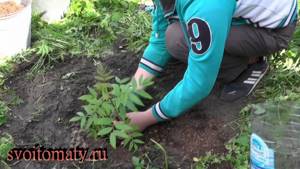
Rules for caring for chokeberry
Lighting
The main requirement of the culture is good illumination of the planting site. The bushes love a lot of sun, but grow poorly in partial shade and produce a meager harvest of low quality. In the shade, fruiting is almost completely absent.
Selecting soil and planting chokeberry
In its natural habitat, the plant grows on sandy prairies, forest edges, rocky cliffs, sandy and rocky glades. As you can see, the culture adapts to different living conditions. But for a good harvest and improved decorative qualities, the shrub is best grown on fertile humus, neutral or slightly acidic soils, and light loams.
Planting chokeberries with an open root system is carried out in spring and autumn; plantings in containers can be planted all season at a distance of 1.5 m from each other. Before placing the seedling in the hole, the soil from it is first mixed with compost and a small amount of peat. Since the bushes produce many lateral root shoots, when planting the root collar is buried 1 cm below the soil surface.

Variety "Autumn-magic"
Such planting will hinder their growth. The ground around the bush is well watered and mulched with pine bark, which is laid around the plantings. It allows you to maintain the acidic reaction of the soil, protects the roots from moisture loss and suppresses the growth of weeds, to which the plant is very sensitive.
Caring for fieldfare in the garden
Growing conditions
Planting and caring for fieldfare will not cause you any trouble. Keep the soil around the bushes loose and slightly moist, remove weeds and root growth, feed the bush if it grows in poor soil, and shape the bushes by pruning if necessary.
Water fieldfare abundantly, especially in dry weather. Feed the plant in small portions at least twice a season, applying fertilizers superficially or covering them shallowly. Peat, compost or humus are used as fertilizer, but sometimes mineral complexes can also be used.
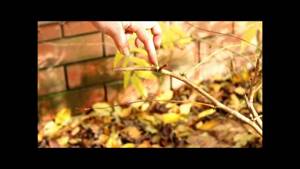
Faded fieldfare inflorescences should be removed, as they significantly reduce the decorative value of the shrub. For sanitary purposes, fieldfare is pruned in early spring: damaged, dry branches that thicken the bush or those affected by pests and diseases are removed. If fieldfare is not thinned out, this will lead to the formation of weak, thin and rapidly aging shoots.
- Korostavnik: cultivation, properties and application
Fieldfare tolerates haircuts well, including radical rejuvenating ones. Don't forget to regularly remove root growth.

Transfer
Replanting the fieldfare will not cause any harm. This procedure can be combined with dividing the bush. In spring or autumn, dig a new hole for the plant in advance, place drainage in it and prepare fertile soil by mixing the soil removed from the hole with humus or compost. Then dig up the fieldfare, if necessary, divide it into parts so that each of them has developed roots and strong shoots, treat the cuts with crushed coal and plant the sections in their designated places.
If you don’t need to divide the bush, simply transplant it into a prepared hole, fill the space with soil mixture, compact the surface around the bush and water the plant generously.
Reproduction of fieldfare
Fieldfare is propagated by dividing the bush, which we just described. When propagating fieldfare by seed, the probability of getting seedlings tends to zero; vegetative methods are much more reliable - propagation by layering and lignified cuttings.
Reproduction of fieldfare by layering gives excellent results. In the spring, tilt a beautiful and long shoot to the ground and pin it to the ground so that several buds are in contact with the soil. Cover the shoot with soil, leaving its top on the surface. Water the cuttings all summer. The roots will appear in just a few weeks, and closer to autumn you can separate the cuttings from the mother bush and plant them in a permanent place.
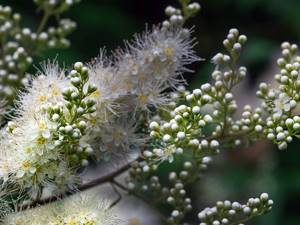
To propagate by cuttings, cut apical segments 20-30 cm long from lignified shoots and plant them in a box with soil mixture. Keep the substrate slightly moist, and the tips of the cuttings starting to grow will be a signal to you that the cuttings were successful.
Pests and diseases
Having high phytoncidal properties, fieldfare is very resistant to diseases and pests, but sometimes it can be affected by spider mites or green aphids.
- How to properly grow godetia from seeds
Both mites and aphids feed on the cell sap of the plant, causing it to wither, its leaves turn yellow, and its shoots become deformed. In addition, sucking pests can be carriers of the incurable disease viral mosaic, and then all you have to do is dig up the bush and burn it. Pests are destroyed with a solution of Mitaka or Fitoverm.
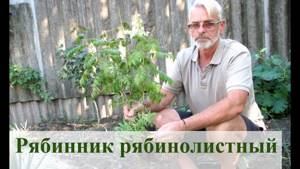
Types and varieties
Only four species of fieldfare can be found in cultivation.
Fieldfare (Sorbaria tomentosa)
Shrub up to 6 m high from East Asia. It grows mainly on mountain slopes, does not bloom and does not tolerate cold well.
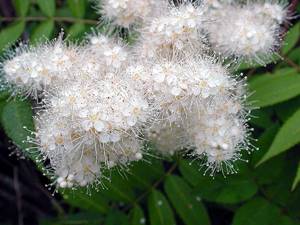
Fieldfare (Sorbaria arborea)
It comes from the same region and reaches the same height. This species blooms from July to August, is frost-resistant, but grows very slowly.
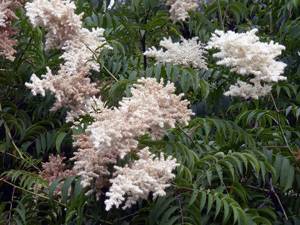
Pallas's Fieldfare (Sorbaria pallasii)
A species found on the rocky slopes of the Far East and Transbaikalia. This is a very beautiful shrub up to 120 cm high. The young shoots of this fieldfare are brown in color, bare or finely pubescent with yellowish branched hairs; on older shoots the bark peels off. The leaves are unpaired-pinnate, usually pubescent with red hairs, linear-lanceolate, up to 15 cm long.
The flowers are creamy or white, up to 15 mm in diameter, collected in small apical panicles. The fruits of Pallas's fieldfare are pubescent leaflets. The plant is frost-resistant.
Fieldfare (Sorbaria sorbifolia)
The most popular cultivated species, in nature it forms thickets on the edges of forests and along the banks of rivers in Siberia, the Far East, China, Korea and Japan. This plant is up to 2 m high with gray-brown straight shoots and odd-pinnate, sharply serrated leaves up to 20 cm long with a pointed tip. When they bloom, the leaves have a pinkish-orange hue, in summer they are light green, and in autumn the foliage turns yellow or carmine red.
The creamy, fragrant flowers of the mountain ash are collected in pyramidal paniculate inflorescences up to 30 cm long. Because of the long stamens, the inflorescences appear fluffy. The fruits of the mountain ash are pitcher-shaped fused leaflets.
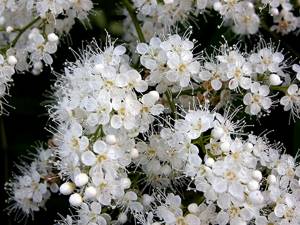
The highly decorative fieldfare Sam deserves special attention - a compact plant up to 120 cm high with a rounded crown, greenish-yellow shoots and leaves with a reddish or copper tint. White flowers are collected in paniculate inflorescences. To preserve the color of the leaves, this variety requires brighter lighting than for the original appearance.
Decorative and fruit trees and shrubs.
Actinidia Kolomikta, Kiwi (about 100 seeds).
Buy actinidia seeds Kolomikta. Actinidia kolomikta (lat. Actinídia kolomíkta), or creeper, is a perennial shrub vine; species of the genus Actinidia. Cultivated as an ornamental and fruit plant. Found in the Far East: China, Japan (Hokkaido, Honshu), Korea; in Primorye, the southern part of the Khabarovsk Territory, the Amur region, the southern and central regions of Sakhalin, Iturup, Kunashir and Shikotan. Actinidia kolomikta grows in many types of forests: in cedar and fir-broad-leaved, broad-leaved spruce and fir-spruce forests, but the most favorable conditions for its growth are created in fir-spruce forests with the participation of cedar and broad-leaved species. Here it reaches its maximum size and forms thickets along the banks of the springs and in cleared areas. It also develops well in clearings and burnt areas, in forest clearings and edges. Being an extra-tiered plant, Actinidia kolomikta is also a characteristic part of the undergrowth along with Maak's honeysuckle, Manchurian hazel, mock orange, Eleutherococcus senticosus, Manchurian aralia - “Devil's tree”, Amur grape and Chinese lemongrass; prefers well-drained humus soils, where it is often found in large numbers. In the form of a small bush with shoots that freeze annually, it grows along the edges of rocky placers, rising into the mountains of Southern Primorye to a height of 1300-1400 m above sea level. At the northern borders of the range it rises into the mountains no higher than 150 m. Actinidia kolomikta is a woody liana. Trunks up to 2 (5) cm in diameter with slightly flaky bark. The shoots are shiny, dark brown, smooth, with curly or erect branches climbing to a height of 14 m or more. Young shoots with numerous longitudinal and dotted light lenticels. Upon contact with the support, the non-lignified vegetative shoot begins to spiral around it in a counterclockwise direction. This occurs when the support thickness is no more than 10 cm. In the presence of a thicker support or in its absence, the upper part of the shoot bends sharply downwards and wraps around its own shoot. An interesting feature is the leaves with changing colors. At the beginning of growth they are bronze, then green; before flowering, the tips of most leaves become bright white, and after flowering they turn pinkish, then crimson-red. In autumn, the leaves turn pink, yellow, light yellow or violet-red. Variegation is especially pronounced in plants growing in sunny areas, but is absent in bushy plants found at the upper limit of distribution in the mountains. Leaves are alternate, on petioles 2-7 cm long, elliptical, less often ovate with a heart-shaped or rounded base, long-pointed, doubly pointed; The leaf blade is thin, short-pubescent along the veins, without bristly hairs below, 5-13 cm long, often asymmetrical. It blooms from 5 years old, in the second ten days of June. Flowering duration is up to 20 days. Blooms in June. The fruits are dark green berries with 12 or more dark longitudinal stripes, oblong, elliptical, less often round. When ripe, they are soft, sweet and aromatic, up to 3 cm long and 1.5 cm wide. The seeds are numerous (up to 90 pieces per berry), small, dark brown or yellowish with a mesh, fine-mesh surface; weight of 1000 seeds is 0.82-1 g. Fruits from 9 years of age, the fruits ripen unevenly in late August - mid-September, and fall off easily when ripe. The fruits are edible. The plant vegetates for about 150 days. It grows quickly in the first three years. Propagates well vegetatively. Under favorable conditions, it lives up to 80-100 years. I. V. Michurin wrote: “We can say with confidence that in the future, actinidia will take one of the first-rate places among the fruit plants of our region, capable of completely displacing grapes in terms of the quality of their fruits... not only replacing it in all types of use, but far surpassing it in the quality of its fruits...” Its fruits taste like strawberries, bananas, watermelon, apples, but most often pineapple; they have tonic and medicinal properties.
200 rub
